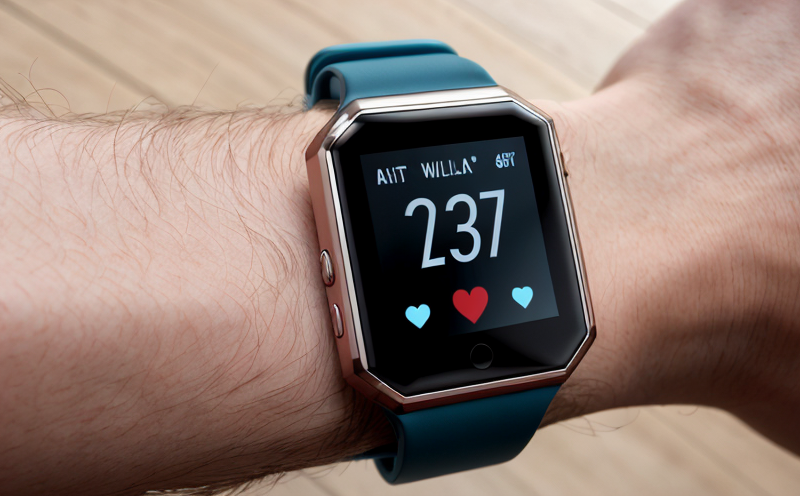ISO 80601-2-30 Blood Pressure Monitoring Wearable Testing
In the realm of medical device testing, ensuring that blood pressure monitoring wearables meet stringent safety and performance standards is critical. This service focuses on the rigorous compliance with ISO 80601-2-30, which specifically addresses the requirements for software aspects of medical devices that perform blood pressure measurement using non-invasive methods.
Blood pressure monitoring wearables are rapidly gaining popularity due to their convenience and accessibility. These devices include smartwatches, fitness trackers, and dedicated blood pressure monitors that integrate into a broader digital health ecosystem. The challenge lies in ensuring these devices provide accurate, reliable, and safe readings while being user-friendly and compliant with international standards.
Our laboratory specializes in providing comprehensive testing services for blood pressure monitoring wearables, focusing on the software aspects as per ISO 80601-2-30. This includes thorough validation of algorithms that calculate systolic, diastolic, and mean arterial pressures, ensuring they meet the specified performance criteria.
The testing process involves several key steps:
- Device setup: Calibration and initial configuration to ensure accurate readings.
- Data collection: Gathering data under various conditions including different environmental factors (temperature, humidity).
- Algorithm validation: Testing the algorithms used for blood pressure calculation against known standards.
- User interface evaluation: Ensuring that the user interaction is intuitive and meets ergonomic requirements.
- Safety assessment: Evaluating potential risks associated with software failures or malfunctions.
The results of these tests are meticulously documented, providing clients with detailed reports that highlight compliance with ISO 80601-2-30. This ensures that the device not only meets regulatory requirements but also performs accurately in real-world scenarios.
Understanding the scope and significance of this standard is crucial for manufacturers aiming to bring their products to market successfully. Compliance with ISO 80601-2-30 helps build consumer trust, enhances product safety, and facilitates easier regulatory approval processes.
| Applied Standards | Description |
|---|---|
| ISO 80601-2-30 | This standard specifies the essential requirements for software aspects of medical devices that perform blood pressure measurement using non-invasive methods. |
| IEC 62304 (Software lifecycle processes) | Ensures that the software used in the device is developed, maintained, and managed effectively throughout its life cycle to ensure safety and performance. |
The implementation of these standards not only enhances product reliability but also supports continuous improvement and innovation. Our team of experts ensures that every aspect of the testing process adheres to these stringent requirements, providing clients with confidence in their device's compliance and performance.
Why It Matters
The importance of ISO 80601-2-30 cannot be overstated, particularly for blood pressure monitoring wearables. These devices play a crucial role in personal health management, enabling users to monitor their blood pressure from the comfort and convenience of their homes or daily activities.
- Consumer Trust: Compliance with international standards instills trust among consumers, making them more likely to use the device regularly.
- Regulatory Approval: Meeting these standards can significantly expedite the regulatory approval process, reducing time-to-market for manufacturers.
- Patient Safety: Ensuring accurate and reliable readings minimizes risks associated with inaccurate medical data, which could lead to incorrect treatment decisions.
Blood pressure monitoring wearables are part of a broader digital health ecosystem that integrates various devices and services. By adhering to ISO 80601-2-30, manufacturers contribute to the overall safety and efficacy of this interconnected system, which is essential for improving public health outcomes.
Applied Standards
The following standards are applied during our testing process:
- ISO 80601-2-30: Specifies the essential requirements for software aspects of medical devices that perform blood pressure measurement using non-invasive methods.
- IEC 62304: Ensures that the software used in the device is developed, maintained, and managed effectively throughout its life cycle to ensure safety and performance.
| Applied Standards | Description |
|---|---|
| ISO 80601-2-30 | This standard specifies the essential requirements for software aspects of medical devices that perform blood pressure measurement using non-invasive methods. |
| IEC 62304 (Software lifecycle processes) | Ensures that the software used in the device is developed, maintained, and managed effectively throughout its life cycle to ensure safety and performance. |
The combination of these standards ensures that the testing process is comprehensive and robust, covering all critical aspects of blood pressure monitoring wearables.
Competitive Advantage and Market Impact
- Innovation: By offering cutting-edge testing services aligned with the latest standards, we help manufacturers stay ahead of regulatory changes.
- Market Entry: Compliance with international standards facilitates easier market entry in different regions, reducing barriers to growth.
The competitive advantage lies not only in meeting these standards but also in providing detailed insights and recommendations for improving product performance. Our expertise ensures that manufacturers can navigate the complex landscape of medical device regulation effectively, giving them a distinct edge over competitors.
- Quality Assurance: By adhering to ISO 80601-2-30, we ensure consistent quality and reliability across different products, enhancing brand reputation.
- User Satisfaction: Accurate and reliable blood pressure monitoring wearables contribute to better user satisfaction, leading to higher customer retention rates.
The market impact of this service extends beyond individual devices. By promoting compliance with international standards, we contribute to the overall safety and efficacy of digital health products, driving positive change in public health.





